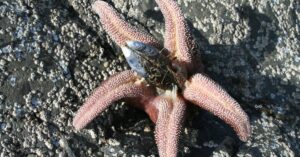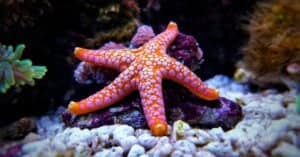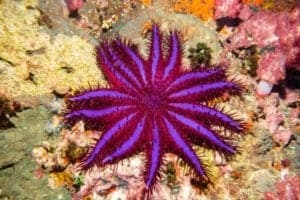Starfish are fascinating sea creatures. Although they have fish in their name, they aren’t actually fish but are marine invertebrates. Invertebrates are cold-blooded animals with no backbone.
Starfish do not have a central nervous system. Instead, their body is made up of a collection of sensory nerves, thin muscles, and tiny ligaments. Starfish don’t use lungs or gills to breathe but get their oxygen through their skin through a process called osmosis.
Starfish, otherwise known as sea stars, are a diverse group of echinoderms that showed up in the fossil record nearly 500 million years ago in the Cambrian Period. Echinoderm means spiny skin, and this group includes other invertebrates such as sea cucumbers, sand dollars, and sea urchins. The spiky skin of the echinoderm helps to protect the small creatures from predators.
Over 2,000 starfish species can be found throughout the world in many ocean habitats such as:
- coral reefs
- coastal waters
- open ocean
- tidal pools
- sandy seabeds
- kelp forests
Starfish have a unique way of eating, which we will get to later, and it may leave you wondering if starfish have teeth. The short answer is no, starfish do not have teeth. However, some species do have teeth-like structures, and others have spiky spines located near their mouth, which may aid in eating.
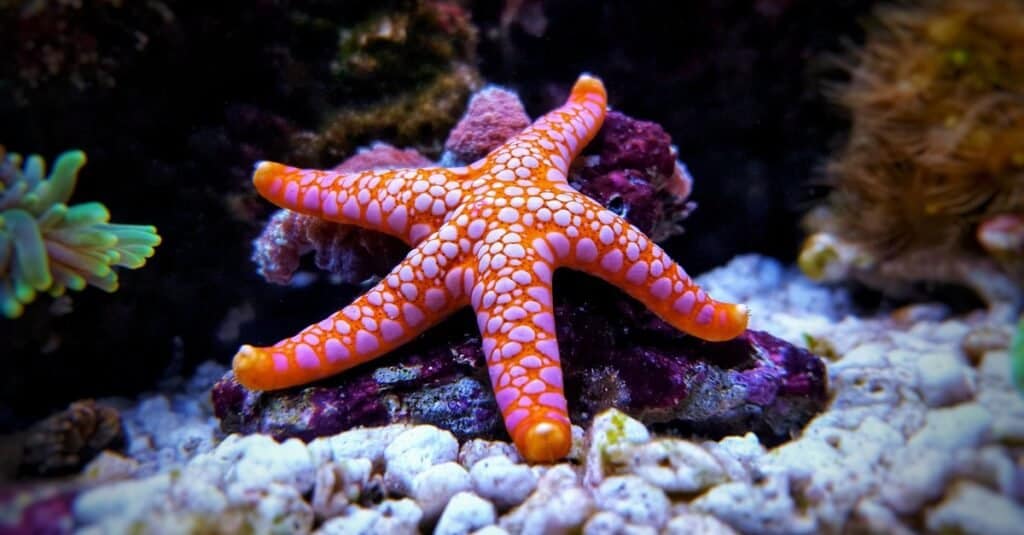
The starfish’s body is made up of a collection of sensory nerves, thin muscles, and tiny ligaments.
©Vojce/Shutterstock.com
Do Starfish Have Teeth?
No, starfish do not have teeth. Starfish are flat, slow-moving animals with a central disk surrounded by five or more arms. Their mouth is typically located in the center of the disk on the bottom of the animal. It does not contain teeth.
However, some species of starfish do have spines located around their mouth. These spines are thought to help them for eating, even though they aren’t used for chewing. And other species have a teeth-like structure called pedicellariae, which scientists have observed can be used by the starfish to help catch small swimming prey, such as fish. The starfish use the pedicellariae to catch their prey, grabbing hold similar to the way that VELCRO® works.
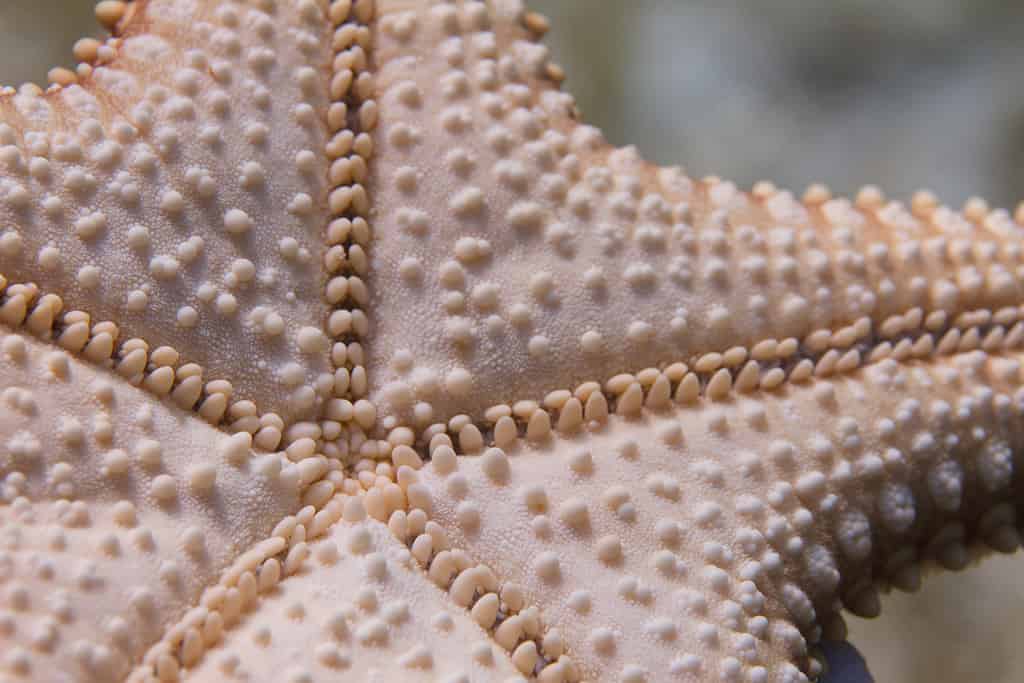
While starfish do not have teeth, some have spines located around their mouth.
©Peter Douglas Clark/Shutterstock.com
Do Starfish Bite?
No, unlike some other marine animals, you don’t have to be wary of a starfish bite. Although they have a mouth, which may have sharp spikes around it depending on the species, starfish don’t have jaws.
Starfish may not bite, but there are species of starfish with toxic venom in their spikes. Fortunately, these starfish live on the ocean floor and use this protection not to attack humans, but to avoid being eaten by predators.
The Unique Way Starfish Use Their Stomachs
Starfish are fascinating animals with a very unusual manner of eating. As we said, they don’t have jaws and cannot bite. So how do they eat?
Starfish eat by pushing their stomachs out of their mouth and catching their prey. Because they digest their food outside their bodies, they can eat animals much larger than their mouths.
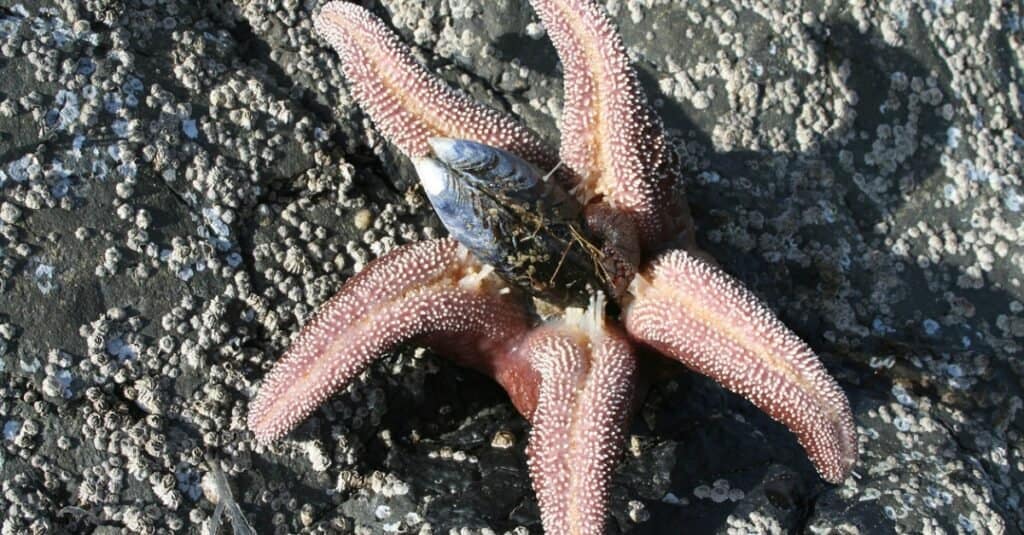
Starfish eat by pushing their stomachs out of their mouth, digesting food outside their body.
©iStock.com/towlake
How Starfish Catch Their Dinner
Although starfish don’t have a central nervous system, they have a network of nerves all over their body that allows them to move in a coordinated manner. When a starfish senses its prey, such as a clam or oyster on the ocean floor, it makes its way over to it using its hundreds of tube feet that are attached to the bottom of its arms. These tiny feet are shaped like suction cups. They allow the creature to scoot across the ocean floor by filling up with water and then contracting and relaxing.
Once the starfish is positioned over the helpless mollusk, rather than take the prey into its mouth to digest it, the starfish’s stomach comes out of its mouth to enclose the animal outside its body. This process is known as eversion. Using eversion, starfish can expel their entire stomach through their mouths.
How Do Starfish Digest Their Food?
Starfish eat their food with two stomachs. Starfish have a cardiac stomach and a pyloric stomach. It’s the cardiac stomach that they use to push out of their mouths to catch their prey.
When the starfish has completely enclosed the prey animal with its cardiac stomach, it begins secreting digestive enzymes to break down the animal. This makes it easier to pull the animal into the starfish’s mouth.
Once the prey is trapped in the starfish’s stomach, the starfish will bring its stomach, prey and all, inside its mouth. The starfish then transfers the food into its second stomach. This is the pyloric stomach. The pyloric stomach is where the starfish finishes digesting its meal internally with powerful digestive enzymes.
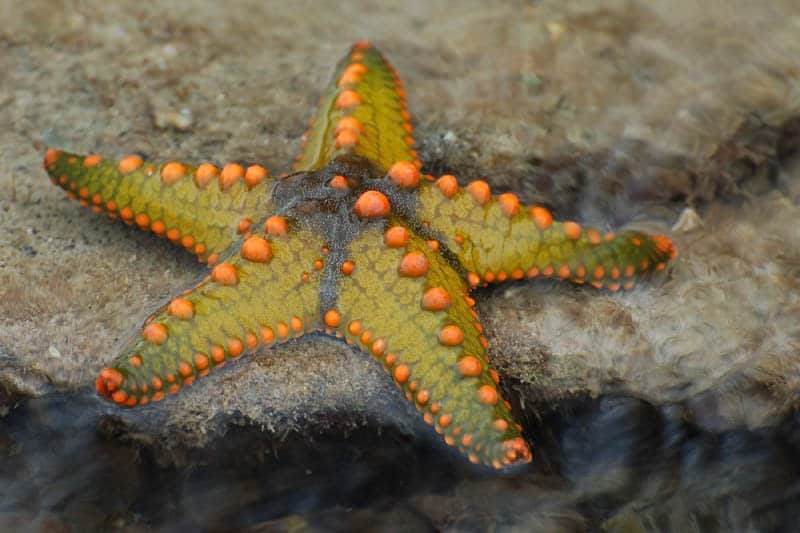
Starfish use hundreds of tube feet that are attached to the bottom of its arms to travel across the ocean floor.
Starfish Diet
With its unique way of eating, you may wonder what is on a starfish’s diet. Starfish are both predators and scavengers. They mainly eat slow-moving mollusks such as clams, mussels, sea snails, and oysters.
However, in addition to eating small prey animals, starfish also are scavengers. This makes them a helpful addition to any aquarium as they keep the aquarium floor clean by eating decomposing organic matter. Starfish have a varied diet and will also eat plankton, barnacles, and even other starfish.
The photo featured at the top of this post is © MikeMurphy (User) / public domain – License / Original
Thank you for reading! Have some feedback for us? Contact the AZ Animals editorial team.



